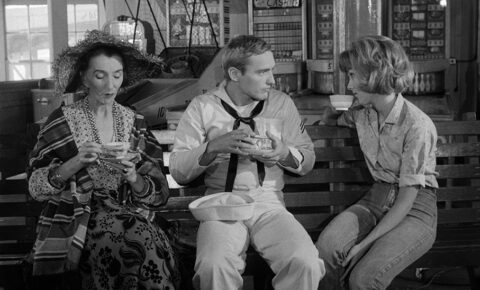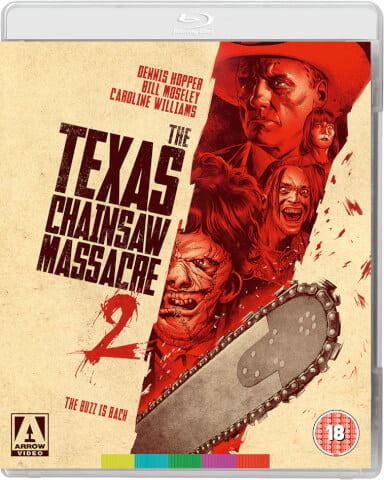Night Tide (1961)
Directed by: Curtis Harrington
Written by: Curtis Harrington
Starring: Dennis Hopper, Gavin Muir, Linda Lawson, Luana Anders
USA
AVAILABLE ON BLU-RAY, DVD and DIGITAL
RUNNING TIME: 84 mins
REVIEWED BY: Dr Lenera

Johnny Drake, a sailor on shore leave in Santa Monica, meets a young woman named Mora who appears as a mermaid in a sideshow attraction on the boardwalk operated by former sea Captain Murdock. The two soon become close, but the merry-go-round operator’s granddaughter Ellen Sands informs Johnny that two of Mora’s previous boyfriends died under mysterious circumstances. Then Murdoch tells him that he’s in great danger and Mora seems to be under the delusion that she really is a mermaid….

“And so, all the night-tide, I lie down by the side Of my darling – my darling – my life and my bride, In the sepulchre there by the sea, In her tomb by the sounding sea.” Edgar Allan Poe’s last complete poem is about a love of a woman so strong it stretches beyond death, and was the starting point for this beguiling little low budget gem despite misunderstanding some Greek mythology. Sirens were not mermaids but were actually half female human / half bird, and there were either only two or five of them depending on the stories. After Odysseus slipped by them, the Sirens dashed themselves onto the rocks, so none survived into the modern era. Does this matter? Not really of course, but I do wish screenwriters would do actual research on such things. I’ve seen Curtis Harrington’s debut feature described as being very much a Val Lewton film, which was the main reason I bought the Blu-ray during Indicator’s last sale, but I don’t think that’s entirely true even though on the disc Harrington himself mention Lewton. While it’s definitely inspired by Cat People, the feel and approach differs somewhat. Yes, the handling is subtle, and characters tend to be nice and are shown with their occupations which was another Lewton trademark, but there isn’t much in the way of scary set pieces. meaning that for many this won’t seem to be a horror film at all, just a romantic fantasy with some dark elements. Also, most of the film takes place on location, great use being made of the somewhat rundown Santa Monica Pier and the area immediately around it. Indeed there’s a rather naturalistic approach employed despite the quirky touches and interesting cinematography. I don’t think I’ve seen any Harrington films before, but this film suggests great things to come which didn’t seem to happen; for every Roger Corman alumni who made it big, as many or more failed to reach their potential.
Harrington based his script, which was originally called The Girl From Beneath The Sea, on a self-penned story titled The Secrets of the Sea. He sold it to Corman in 1960, nobody else being interested except for the Mickey Cohen gang. Harrington later said that, “They were very charming men but I had visions that if the film didn’t do well I’d end up at the bottom of the LA river in a block of cement!”. This was Dennis Hopper’s first lead role, and he had his sailor suit slightly darkened so it would look better on film. During shooting, Hopper was spotted by military police who threatened to arrest him for wearing a dirty uniform, while Linda Lawson’s husband was frequently around keeping a very close eye on his wife’s love scenes. Hopper also recalls that he came across Ursula Andress on a yacht with Hugh O’ Brien; Andress begged Hopper not to tell her husband John Derek. Peter Lorre was approached to play the role of Murdock, but the filmmakers couldn’t afford the salary he demanded. In fact the $28,000 budget [according to Hopper] couldn’t stretch to much at all, including extras; friends of the crew played peripheral characters. Hopper got drunk on the last day of filming and had a motorbike crash which kept him in hospital for two weeks until his last shots could be done. Then Harrington didn’t have the money to pay the lab bill, and the lab involved, Pathé, threatened to take possession of the negative. Eventually Corman stepped in and asked Pathé to hold off on their legal actions to allow Corman’s Filmgroup production company to distribute the film, guaranteeing Pathé $15,000 within 12 months of the film’s release. though in the end it was American International Pictures who licensed it for a wider release, double billed with The Raven. Over time the original film elements were lost, though the HD restoration, supervised by Nicholas Winding Refn, looks mostly fine.
Of course we open with shots of the sea brushing on to the beach; how many films begin this way? But of course with this one it’s important to the film, the “night tide” during the full moon being when it’s strongest and when mermaids on land have to return to their kin. We’re not told why, but I’ll hazard a guess and say that maybe they will die if they spend any more time on land? Anyway, we then see Johnny, leaning against a barrier on the pier, looking out to sea. Is he subconsciously inviting a mermaid into his life? We follow him around the pier and its attractions before he wonders into a jazz bar, and it’s real cool jazz here, where the players are able to improvise for ages with no disruption of mood, so much so that your mind may be distracted from Johnny and his instant attraction to Mona, who he sees sitting on her own like him. He asks if he can sit with her so he can see the band properly, but she turns down his offer to buy her a drink. Then a mysterious old lady appears who looks much like an elderly version of Mona; she speaks to Mona in Greek and Mona quickly leaves. Johnny is able to catch up with her and walk her home, but did we need him suddenly kissing her? It seems way too soon and undermines the sweetness and innocence of Johnny, who joined the navy to see the world but hasn’t seen very much of it yet; his little walking on a barrier just after he’s left her is lovely. The next morning he returns for breakfast at her apartment on the pier; she impresses him by being able to grab and calm down a seagull. However, he’s not sure how to react when she goes into a trance when dancing to two drummers at a beach gathering before that old woman shows up again and Mona faints. It’s a really memorable sequence this. Mona’s dancing is strange, sexy and primal all at the same time; it’s best shown as a reflection on a large rock, with the lady in shadow looking like some primitive person from prehistory about to be painted onto that very same wall. It’s understandable that Johnny is bewitched.

However, a detective shows up at the pier having apparently found “new clues” about some case. The merry-go-round operator’s granddaughter Ellen tells Johnny that this concerns Mora who had two exes die. And the boardwalk’s owner Captain Murdock says to him that he’s in “grave danger”. Apparently Murdock found Mona on a Greek island when she was not just a child but a real genuine mermaid and brought her to the United States where she was able to work as a mermaid in a sideshow, but Johnny doesn’t believe this nonsense, all that’s important is that he’s in love, though you’d think that he’d have second thoughts after he has a nightmare where Mona comes towards him, they embrace and he notices that she has a tail, before a cut to Johnny being strangled by an octopus. Said creature is one of those ones which doesn’t seem to move and therefore requires the actor in danger to create the illusion, but by now we’re so involved in the tale that it doesn’t really matter. We feel for both Johnny and Mona, whether the latter is a murderer or not. Poor Johnny is lost in some kind of almost existential maze. That annoying old lady rings Johnny then puts the phone down, and he then see her walking away from a phone booth so he follows her – and ends up at Murdock’s house while the lady has disappeared. Where did she go? Into Murdock’s house? The much bigger question as to whether Mona is a mermaid or not is never answered, even though we do eventually see her in her sideshow attraction form. As things conclude, there appears to be a rational explanation for everything, with there really being a dangerous threat but it being human – it’s really quite well worked out – but then we’re reminded of something which doesn’t tie in with what we’ve just had explained to us, like the scarf left at the end of Portrait Of Jennie which tells Joseph Cotten and us that maybe Jennie did exist after all. These days, this kind of conclusion can seem like a bit of a cop out, but in any case I’ll take fantasy over reality any day.
Of course it’s sex that’s the biggest fear, even though the script never explicitly states it. Did Mona kill those two previous beaus while making love, the act causing her to become a deadly sea creature? And what’s she really trying to do in the underwater climax – look closely. Night Tide is paced leisurely, with Johnny and us spending much time with convincing supporting characters without detracting from the main plot which has a real sense of mystery and tragedy about it. A hand reader is a cliched character – you know exactly what her part in proceedings is going to be – but she still makes a great first impression, complaining about tea bags. Murdock is interesting. The typically heavy drinking ex-sea Captain keeps a severed hand in a bar [“just a little Arabian souvenir”] and is disappointed when he and Johnny can’t exchange tales of sea life because of Johnny’s inexperience. Then there’s Ellen. She clearly falls for Johnny as quickly as Johnny falls for Mona and even says as much in a few lines which apply to Johnny’s feelings for Mona and her feelings for Johnny; the most important moment is when she pretends she was going to make coffee just because Johnny’s just showed up. Harrington’s script avoids cliched protestations of love or adoration from her, even in her final scene. In fact dialogue is generally strong in what is quite a talky 84 mins – I wasn’t at all bored, what with the setting virtually being a character in the film itself – but those expecting creepy moments will be let down. Harrington prefers to suggest the existence of a different world in a much more subtle way, with the providing of a dreamy undercurrent where even filmmaking limitations such as shots being not quite in focus adds to the disquieting atmosphere even if this was not intended. A highlight is when three shots take us closer to Johnny’s bewildered face, before an almost expressionistic montage of the fairground to represent Johnny entering this environment after being literally lost at sea.
It’s perhaps hard to adjust to Hopper as a quiet, rather melancholy person. He’s very uncertain in front of the camera, but this seems to make him more likeable. His character seems painfully lonely, as if loneliness could be the real monster here. Linda Lawson is fittingly remote and enigmatic, but the strongest performance may be from from Luana Anders who’s able to show that her character is in love while remaining subtle. On the opposite end of the scale is some appaling acting by a thespian called H. E. West as a detective character who thankfully is only in one scene. That’s the way it often is with these things though. Then there’s David Raksin’s fascinating musical score, which is largely based on jazz sonorities and harmonies. There are times when it’s perhaps to in your face when no accompaniment is probably needed, but it reaches some hugely emotive peaks during the film’s two dramatic high points where water is used for great dramatic effect. I wonder how Harrington was able to get a “name” composer for his little film? It’s all very haunting, but mostly in an uncertain manner. Boiled down to it, most of Night Tide actually consists of Johnny going from person to person, bumbling about, being told things, yet almost every frame is well-composed, and you can almost smell the salt air. Harrington has achieved a lot here, with very little. This film will leave a lasting impression, even if it fails to actually grab you. It’s almost Carnival Of Soul‘s cousin.







Be the first to comment